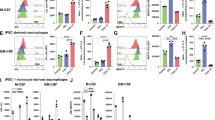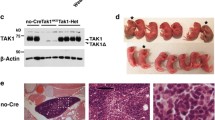Abstract
Macrophages and polymorphonuclear cells (PMNs) rapidly respond to microbial and immune inflammatory stimuli and die during these responses. We have shown earlier that many macrophage and PMN functions are compromised in x-linked immunodeficient (Xid) mice with functional deficiency in Bruton’s tyrosine kinase (Btk). We now report that Btk-deficient macrophages show enhanced susceptibility to apoptotic death on exposure to the microbial and immune inflammatory signals bacterial lipopolysaccharide (LPS) and interferon-gamma (IFNγ) in vitro. In vivo in mixed bone marrow (BM) chimeras Btk deficiency leads primarily to loss of peripheral macrophage numbers without affecting BM development, suggesting a role of inflammation-induced apoptosis in regulating macrophage life span. Surprisingly, Btk deficiency does not affect macrophage apoptosis induced by DNA damage or CD95 engagement. Reactive nitrogen and oxygen species also do not contribute to inflammation-induced apoptosis, but apoptotic process involves loss of mitochondrial potential, shows increased activation of caspase 9 and enhanced loss of Bcl-xL. The lack of pro-survival signaling through the Btk-phosphotidylinositol 3-kinase-Akt pathway, and persistent MEK signaling, lead to enhanced death in Btk-deficient macrophages only downstream of inflammatory triggers. These data underline the complex role of Btk in the regulation of macrophage survival and function.






Similar content being viewed by others
References
Qiu Y, Kung HJ (2000) Signaling network of the Btk family kinases. Oncogene 19:5651–5661
Himmelmann A, Thevenin C, Harrison K, Kehrl JH (1996) Analysis of the Bruton’s tyrosine kinase gene promoter reveals critical PU1 and SP1 sites. Blood 87:1036–1044
de Weers M, Verschuren MC, Kraakman ME et al (1993) The Bruton’s tyrosine kinase gene is expressed throughout B cell differentiation, from early precursor B cell stages preceding immunoglobulin gene rearrangement up to mature B cell stages. Eur J Immunol 23:3109–3114
Takagi Y, Masui N, Yasuda M, Ono S (2007) A new molecular genetic diagnosis of the Btk(xid) mice. Exp Anim 56:63–66
Conley ME, Mathias D, Treadaway J, Minegishi Y, Rohrer J (1998) Mutations in btk in patients with presumed X-linked agammaglobulinemia. Am J Hum Genet 62:1034–1043
Teimourian S, Nasseri S, Pouladi N, Yeganeh M, Aghamohammadi A (2008) Genotype-phenotype correlation in Bruton’s tyrosine kinase deficiency. J Pediatr Hematol Oncol 30:679–683
Gray P, Dunne A, Brikos C, Jefferies CA, Doyle SL, O’Neill LA (2006) MyD88 adapter-like (Mal) is phosphorylated by Bruton’s tyrosine kinase during TLR2 and TLR4 signal transduction. J Biol Chem 281:10489–10495
Liljeroos M, Vuolteenaho R, Morath S, Hartung T, Hallman M, Ojaniemi M (2007) Bruton’s tyrosine kinase together with PI 3-kinase are part of Toll-like receptor 2 multiprotein complex and mediate LTA induced Toll-like receptor 2 responses in macrophages. Cell Signal 19:625–633
Horwood NJ, Page TH, McDaid JP et al (2006) Bruton’s tyrosine kinase is required for TLR2 and TLR4-induced TNF, but not IL-6, production. J Immunol 176:3635–3641
Schmidt NW, Thieu VT, Mann BA, Ahyi AN, Kaplan MH (2006) Bruton’s tyrosine kinase is required for TLR-induced IL-10 production. J Immunol 177:7203–7210
Doyle SL, Jefferies CA, O’Neill LA (2005) Bruton’s tyrosine kinase is involved in p65-mediated transactivation and phosphorylation of p65 on serine 536 during NFkappaB activation by lipopolysaccharide. J Biol Chem 280:23496–23501
Mukhopadhyay S, Mohanty M, Mangla A et al (2002) Macrophage effector functions controlled by Bruton’s tyrosine kinase are more crucial than the cytokine balance of T cell responses for microfilarial clearance. J Immunol 168:2914–2921
Mukhopadhyay S, George A, Bal V, Ravindran B, Rath S (1999) Bruton’s tyrosine kinase deficiency in macrophages inhibits nitric oxide generation leading to enhancement of IL-12 induction. J Immunol 163:1786–1792
Mukhopadhyay S, Sahoo PK, George A, Bal V, Rath S, Ravindran B (1999) Delayed clearance of filarial infection and enhanced Th1 immunity due to modulation of macrophage APC functions in xid mice. J Immunol 163:875–883
Zorn CN, Keck S, Hendriks RW, Leitges M, Freudenberg MA, Huber M (2009) Bruton’s tyrosine kinase is dispensable for the Toll-like receptor-mediated activation of mast cells. Cell Signal 21:79–86
Cancro MP, Sah AP, Levy SL, Allman DM, Schmidt MR, Woodland RT (2001) Xid mice reveal the interplay of homeostasis and Bruton’s tyrosine kinase-mediated selection at multiple stages of B cell development. Int Immunol 13:1501–1514
Mangla A, Khare A, Vineeth V et al (2004) Pleiotropic consequences of Bruton tyrosine kinase deficiency in myeloid lineages lead to poor inflammatory responses. Blood 104:1191–1197
Uckun FM (2008) Clinical potential of targeting Bruton’s tyrosine kinase. Int Rev Immunol 27:43–69
Islam TC, Smith CI (2000) The cellular phenotype conditions Btk for cell survival or apoptosis signaling. Immunol Rev 178:49–63
Kawakami Y, Miura T, Bissonnette R et al (1997) Bruton’s tyrosine kinase regulates apoptosis and JNK/SAPK kinase activity. Proc Natl Acad Sci USA 94:3938–3942
Anderson JS, Teutsch M, Dong Z, Wortis HH (1996) An essential role for Bruton’s (corrected) tyrosine kinase in the regulation of B-cell apoptosis. Proc Natl Acad Sci USA 93:10966–10971
Uckun FM (1998) Bruton’s tyrosine kinase (BTK) as a dual-function regulator of apoptosis. Biochem Pharmacol 56:683–691
Marriott HM, Dockrell DH (2007) The role of the macrophage in lung disease mediated by bacteria. Exp Lung Res 33:493–505
Guiney DG (2005) The role of host cell death in Salmonella infections. Curr Top Microbiol Immunol 289:131–150
Melcher M, Unger B, Schmidt U, Rajantie IA, Alitalo K, Ellmeier W (2008) Essential roles for the Tec family kinases Tec and Btk in M-CSF receptor signaling pathways that regulate macrophage survival. J Immunol 180:8048–8056
Nakajima H, Golstein P, Henkart PA (1995) The target cell nucleus is not required for cell-mediated granzyme- or Fas-based cytotoxicity. J Exp Med 181:1905–1909
Sade H, Sarin A (2003) IL-7 inhibits dexamethasone-induced apoptosis via Akt/PKB in mature peripheral T cells. Eur J Immunol 33:913–919
Seminara AR, Ruvolo PP, Murad F (2007) LPS/IFNgamma-induced RAW 264.7 apoptosis is regulated by both nitric oxide-dependent and -independent pathways involving JNK and the Bcl-2 family. Cell Cycle 6:1772–1778
Albina JE, Cui S, Mateo RB, Reichner JS (1993) Nitric oxide-mediated apoptosis in murine peritoneal macrophages. J Immunol 150:5080–5085
DeLeo FR (2004) Modulation of phagocyte apoptosis by bacterial pathogens. Apoptosis 9:399–413
Gao W, Pereira MA (2001) Trypanosoma cruzi trans-sialidase potentiates T cell activation through antigen-presenting cells: role of IL-6 and Bruton’s tyrosine kinase. Eur J Immunol 31:1503–1512
Wesche DE, Lomas-Neira JL, Perl M, Chung CS, Ayala A (2005) Leukocyte apoptosis and its significance in sepsis and shock. J Leukoc Biol 78:325–337
Chung CS, Song GY, Lomas J, Simms HH, Chaudry IH, Ayala A (2003) Inhibition of Fas/Fas ligand signaling improves septic survival: differential effects on macrophage apoptotic and functional capacity. J Leukoc Biol 74:344–351
Lee JH, Tak JK, Park KM, Park JW (2007) N-t-Butyl hydroxylamine regulates ionizing radiation-induced apoptosis in U937 cells. Biochimie 89:1509–1516
Noguchi T, Ishii K, Fukutomi H et al (2008) Requirement of reactive oxygen species-dependent activation of ASK1-p38 MAPK pathway for extracellular ATP-induced apoptosis in macrophage. J Biol Chem 283:7657–7665
Jones BW, Heldwein KA, Means TK, Saukkonen JJ, Fenton MJ (2001) Differential roles of Toll-like receptors in the elicitation of proinflammatory responses by macrophages. Ann Rheum Dis 60(Suppl 3):iii6–iii12
Navarro A, Anand-Apte B, Tanabe Y, Feldman G, Larner AC (2003) A PI-3 kinase-dependent, Stat1-independent signaling pathway regulates interferon-stimulated monocyte adhesion. J Leukoc Biol 73:540–545
Datta SR, Brunet A, Greenberg ME (1999) Cellular survival: a play in three Akts. Genes Dev 13:2905–2927
Moon DO, Park C, Heo MS, Park YM, Choi YH, Kim GY (2007) PD98059 triggers G1 arrest and apoptosis in human leukemic U937 cells through downregulation of Akt signal pathway. Int Immunopharmacol 7:36–45
Acknowledgments
We thank Dr Apurva Sarin, National Centre for Biological Sciences, Bangalore, India, for discussions and critical inputs in the manuscript. This work was supported in part by grants from Council for Scientific and Industrial Research, Government of India (A.K., R.G.), Indian Council of Medical Research, Government of India (B.R., S. R., V.B.), Department of Science and Technology, Government of India (V.B.) and Department of Biotechnology, Government of India (A.G., S.R., V.B.). The National Institute of Immunology and Institute of Life Sciences are supported by the Department of Biotechnology, Government of India.
Conflict of interest
The authors declare they have no conflict of interest.
Author information
Authors and Affiliations
Corresponding author
Additional information
Anna George, Satyajit Rath, Vineeta Bal are Joint senior investigators.
Electronic supplementary material
Below is the link to the electronic supplementary material.
Rights and permissions
About this article
Cite this article
Khare, A., Viswanathan, B., Gund, R. et al. Role of Bruton’s tyrosine kinase in macrophage apoptosis. Apoptosis 16, 334–346 (2011). https://doi.org/10.1007/s10495-010-0569-6
Published:
Issue Date:
DOI: https://doi.org/10.1007/s10495-010-0569-6




